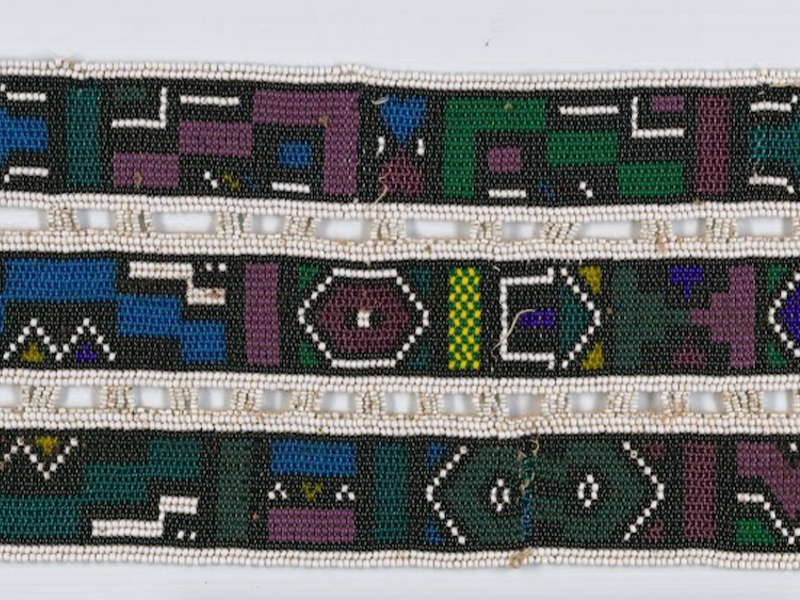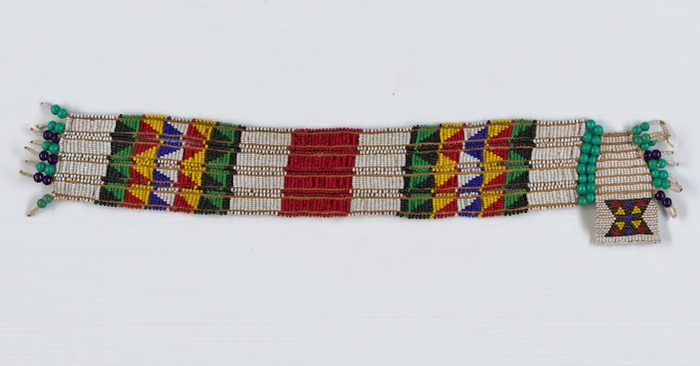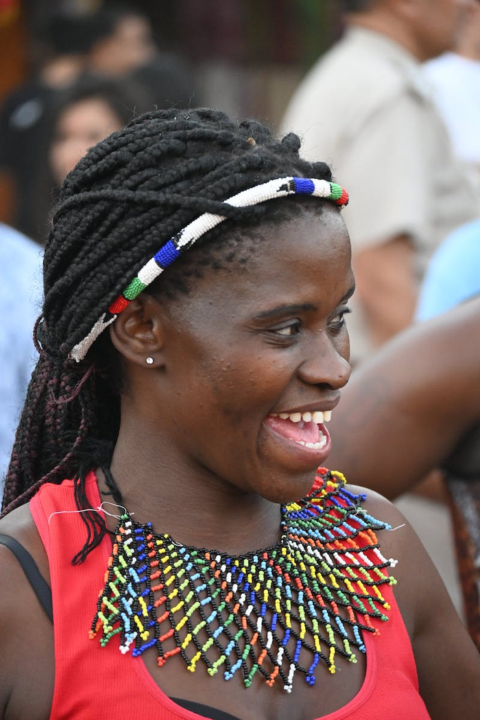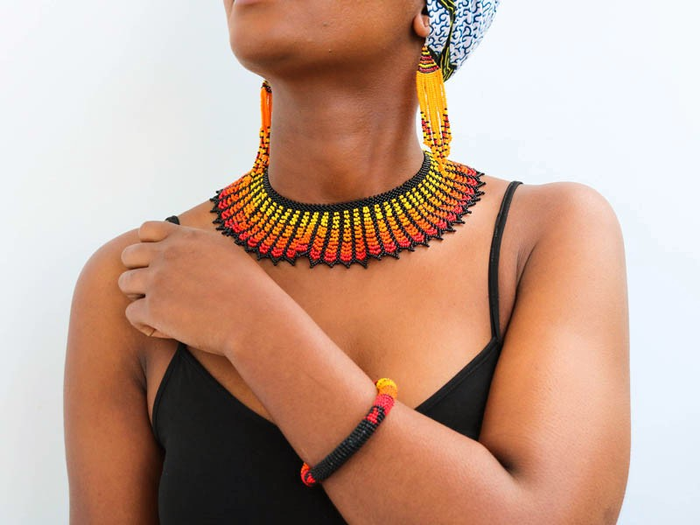
Traditional Zulu beadwork at the Iziko Museums of Cape Town. Source: Google Arts & Culture
The Zulu nation of Southern Africa is famous for its rich cultural heritage, which the people express in its diverse art forms. One of such is its stunning beadwork which is meticulously crafted, using vibrant colors and patterns. The Zulu people have maintained a rich tradition of beadwork, which serves as visual narratives, communicating stories of cultural heritage, spirituality, and social status.
Beyond its visual appeal, the beadwork holds significant cultural and social importance. It is a tangible manifestation of the Zulu people’s values, beliefs, and history.
From elaborate ceremonial attire to everyday accessories, beadwork adorns Zulu women and men, symbolizing their identity, achievements, and community affiliations. From the vibrant color to the intricate designs, one cannot help but marvel at the artistic finesse of the Zulu people. Let’s delve into the historical roots of Zulu beadwork.
Its history can be traced back many centuries. Archaeological evidence suggests pieces of bone, small horns, shells, and small pieces of polished wood and stone were pierced to make “beads” and strung together as necklaces and belts. This was long before the arrival of Europeans. By the end of the 18th century, glass and ceramic beads were introduced, as trade routes expanded and these items began to be heavily used in trade with Europeans. This greatly influenced the evolution of South African beadwork.
During the colonial era, beads were used by Africans to express their identity covertly and communicate messages within a society that restricted their cultural practices.

Traditional Zulu beadwork at the Iziko Museums of Cape Town. Source: Google Arts & Culture
The Craftsmanship and Techniques Involved

Woman modeling modern Zulu beadwork jewelry. Photo by jack minkyi minkyi
A lot of work goes into producing this world-famous and distinctive African art form. The craft is labor-intensive and requires patience and skill.
Firstly, the artisans select the beads they will use, which come in a wide range of colors and sizes. The color choice is important because each has a symbolic meaning. Next, the beads are strung onto a thread or wire to create patterns and designs, using a variety of stitches and techniques.
Several techniques are used, and each has its unique characteristics and cultural associations. Some of the notable ones include:
Stringing: This technique is the most basic form of beadwork which involves threading beads onto a string or wire. It is commonly used for necklaces, bracelets, belts, and other decorative items.
Embroidery: Artisans make detailed patterns and designs using needle and thread to sew beads onto fabric. This technique is commonly seen in traditional clothing, ceremonial attire, and decorative tapestries.
Bead weaving: This is another technique that uses needle and thread. Beads are interlocked, creating complex patterns and motifs. This is commonly used for creating beaded bags, amulets, and ceremonial regalia
Wirework: Wires are skillfully manipulated to create intricate beaded sculptures, three-dimensional figures, and functional objects like baskets and bowls. Beads are added for embellishment.
Meanings Attached to the Designs and Colors
While you’re strutting around showing off your colorful beaded jewelry, have you ever thought of the message behind what you’re wearing? Do you know that the color, shape, and design are symbolic? Let’s break it down.
The beadwork is a form of communication among the Zulu people. The only shape used in their bead jewelry is the triangle because of the representation that each endpoint represents. The triangle represents the fundamental unit of society, the father, mother, and child. The way the triangles are positioned, whether pointing up or down or joined with another, within a particular beadwork, holds a specific meaning. One can tell the gender of the person wearing it and if they are married by the way that the tip of the triangle is pointing. For example, if the triangle’s tip is pointing up it means that the woman is unmarried. For men, if the triangle’s tip is pointing down, it’s a pointer that he is unmarried.
Another way the Zulu community communicates with the beadwork is by color. Each color has its own meaning. However, unlike the shapes which have set and constant meanings, the colors used can have positive or negative meanings, depending on the context in which the beads are used within the jewelry piece. The seven colors are:
Black – a symbol of marriage, but it can also hold a negative connotation of sadness and loneliness.
Blue – a symbol of faithfulness and hope, but it can also convey hostility.
Green – a symbol of contentment, but it can also convey jealousy.
Pink – a symbol of high status and a promise, but it can also represent poverty and laziness.
Red – a symbol of strong emotions and love, but it can also represent anger and heartache.
White – a symbol of purity, spirituality, and true love, with no negative meaning.
Preserving the Zulu Beadwork

Modern Zulu beadwork jewelry by narukicrafts at Afrikea.com
The Zulu beadwork remains an essential element of South African heritage. Therefore, safeguarding and preserving this tradition is important. Over the years, people from different parts of the world have come to recognize and appreciate this complex and intricate craft that combines traditional techniques with contemporary adaptations. This visually striking work of art has become a symbol of African culture, inspiring fashion designers, jewelry makers, and collectors worldwide.
Though in modern times, people from all walks of life wear the beadwork as a fashion accessory, it is more than that. The Zulu beadwork continues to be an important part of the Zulu culture and a powerful symbol of African heritage.
To preserve this tradition, efforts have been made to pass on knowledge and skills from older generations to younger ones through community workshops, cultural festivals, and collaborations with contemporary artists. We can also play a part by supporting fair trade initiatives and ethical practices. This will empower artisans involved in the extraordinary craft and ensure its continuation.




